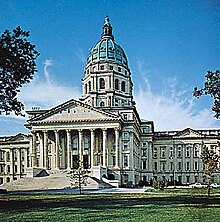Kansas Legislature
| Kansas Legislature | |
|---|---|
 |
|
| Type | |
| Type | |
| Houses |
Kansas Senate Kansas House of Representatives |
| Leadership | |
|
Senate Majority Leader
|
|
|
Speaker of the House
|
|
|
House Majority Leader
|
|
| Structure | |
| Seats | 165 |
|
Senate political groups
|
Republican: 32 Democratic: 8 |
|
House political groups
|
Republican: 97 Democratic: 28 |
| Authority | Kansas Constitution |
| Elections | |
|
Senate last election
|
November 8, 2016 |
|
House last election
|
November 8, 2016 |
|
Senate next election
|
November 9, 2021 |
|
House next election
|
November 12, 2018 |
| Meeting place | |
 |
|
| Kansas State Capitol, Topeka | |
The Kansas Legislature is the state legislature of the U.S. state of Kansas. It is a bicameral assembly, composed of the lower Kansas House of Representatives, with 125 state representatives, and the upper Kansas Senate, with 40 state senators.
Prior to statehood, separate pro-slavery and anti-slavery territorial legislatures emerged, drafting four separate constitutions, until one was finally ratified and Kansas became a state in 1861. Republicans hold a long-standing supermajority in both houses of the state legislature, despite a short-lived dominance by the Populist Party. The state legislature approved one of the first child labor laws in the nation.
Composed of 165 state lawmakers, the state legislature meets at the Kansas State Capitol in Topeka once a year in regular session. Additional special sessions can be called by the governor of Kansas.
The Kansas Territory was created out of the Kansas-Nebraska Act in 1854. In several of the provisions of the act, the law allowed the settlers of the newly created territory to determine, by vote, whether Kansas, once statehood was achieved, would be entered as either a free or a slave state. The act created a rush of both abolitionist Northern and pro-slavery Southern immigrants to the territory, hoping that strength through numbers would place Kansas in their camp. Animosities between the newly arrived sides quickly turned into open violence and guerrilla warfare, giving name to this period known as Bleeding Kansas.
...
Wikipedia
